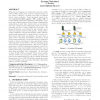Free Online Productivity Tools
i2Speak
i2Symbol
i2OCR
iTex2Img
iWeb2Print
iWeb2Shot
i2Type
iPdf2Split
iPdf2Merge
i2Bopomofo
i2Arabic
i2Style
i2Image
i2PDF
iLatex2Rtf
Sci2ools
WWW
2007
ACM
2007
ACM
Dynamic personalized pagerank in entity-relation graphs
Extractors and taggers turn unstructured text into entityrelation (ER) graphs where nodes are entities (email, paper, person, conference, company) and edges are relations (wrote, cited, works-for). Typed proximity search of the form type=person NEAR company"IBM", paper"XML" is an increasingly useful search paradigm in ER graphs. Proximity search implementations either perform a Pagerank-like computation at query time, which is slow, or precompute, store and combine per-word Pageranks, which can be very expensive in terms of preprocessing time and space. We present HubRank, a new system for fast, dynamic, spaceefficient proximity searches in ER graphs. During preprocessing, HubRank computes and indexes certain "sketchy" random walk fingerprints for a small fraction of nodes, carefully chosen using query log statistics. At query time, a small "active" subgraph is identified, bordered by nodes with indexed fingerprints. These fingerprints are adapt...
| Added | 21 Nov 2009 |
| Updated | 21 Nov 2009 |
| Type | Conference |
| Year | 2007 |
| Where | WWW |
| Authors | Soumen Chakrabarti |
Comments (0)

